Engine overheating
When the engine is overheating, the information screen in the multi-information
display will be interrupted and the engine coolant temperature warning display will
appear. Also  will blink.
will blink.
If this occurs, take the following corrective measures: 1. Stop the vehicle in
a safe place.
2. Check whether steam is coming from the engine compartment.
[If steam does not come from the engine compartment]
With the engine still running, raise the bonnet to ventilate the engine compartment.
![]() Note
Note
► For vehicles equipped with the Auto Stop & Go (AS&G) system, press the “Auto Stop & Go (AS&G) OFF” switch to deactivate the Auto Stop & Go (AS&G) system before stopping the vehicle. Refer to “To deactivate”.
[If steam is coming from the engine compartment]
Stop the engine, and when the steam stops, raise the bonnet to ventilate the engine compartment.
Restart the engine.
![]() Warning
Warning
► Do not open the bonnet while steam is coming from the engine compartment.
It could cause steam or hot water to spurt out, causing burns. Hot water could spurt
out even when there is no steam coming out, and some parts will be very hot. Be
very careful when opening the bonnet.
► Be careful of hot steam, which could be blowing off the reserve tank cap.
► Do not attempt to remove the radiator cap while the engine is hot.
3. Confirm that the cooling fans are turning. If the fans are not turning, stop the engine immediately and have it checked.
1600 models
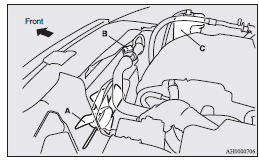
A- Cooling fans
B- Radiator cap
C- Reserve tank
1800 models, 2000 models
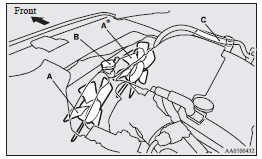
A- Cooling fans
B- Radiator cap
C- Reserve tank
: If so equipped
![]() Warning
Warning
► Be careful not to get your hands or clothes caught in the cooling fan.
4. When the bar graph in the engine coolant temperature warning display in the multi-information display drops, stop the engine.
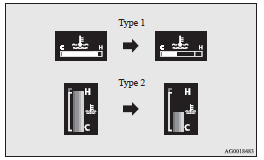
5. Check the coolant level in the reserve tank (D).
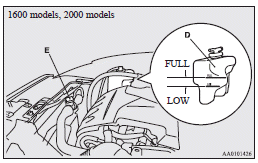
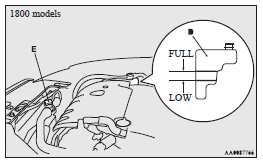
![]() Warning
Warning
► If there is none, make sure that the engine has cooled down before removing the radiator cap (E), because hot steam or boiling water otherwise will gush from the filler port and may scald you.
6. Add coolant to the radiator and/or reserve tank if necessary. (Refer to the “Maintenance” section.)
![]() Caution
Caution
► Do not add coolant while the engine is hot. Suddenly adding cold coolant could damage the engine. Wait for the engine to cool down, then add coolant a little at a time.
7. Examine the radiator hoses for coolant leakage and the drive belt for looseness or damage.
If there is anything wrong with the cooling system or drive belt, we recommend you to have it checked and repaired.
See also:
Vehicles with sunroof
Room lamp
1 (OFF) - The lamp goes out. 2 ()
- The lamp illuminates when a door or the tailgate is opened and goes out when it
is closed. 3 (ON) - The lamp illuminates.
Spot lamps
4 - The la ...
Emergency starting
If the engine cannot be started because the battery is weak or dead, the battery
from another vehicle can be used with jumper cables to start the engine.
Warning
► To start the engine using ...
Running-in recommendations
During the running-in period for the first 1,000 km (620 miles), it is advisable
to drive your new vehicle using the following precautions as a guideline to aid
long life as well as future economy ...
